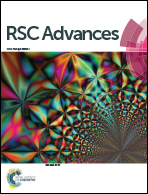Characterization and charge transfer properties of organic BODIPY dyes integrated in TiO2 nanotube based dye-sensitized solar cells†
Abstract
In this work, dye-sensitized solar cells using vertically-aligned TiO2 nanotubes grafted with an organic BODIPY dye are presented for the first time. The properties and performance of the BODIPY cells are compared to the ones of cells with a similar architecture but sensitized with the commercial N719 dye. The individual BODIPY dye molecules have 27 time higher photon-to-electron conversion efficiency than N719 dye molecules. Then, even with 100 times less BODIPY molecules grafted on the surface of the TiO2 nanotubes, the power conversion efficiency of the cells with BODIPY dye only decreased by a factor of 4 when compared to cells with N719 dye. This suggests good light absorption and charge transfer of the BODIPY molecules. Spectroscopic and electrochemical impedance methods were combined to experimentally measure the photochemical properties of the BODIPY dye and to explain the performance differences between solar cells based on the two dyes. Moreover, density function theory calculations were carried out to determine the electronic structure of the BODIPY molecules and allow to propose modifications of their chemical structures that would further enhance their solar to electrical energy conversion efficiency.



 Please wait while we load your content...
Please wait while we load your content...